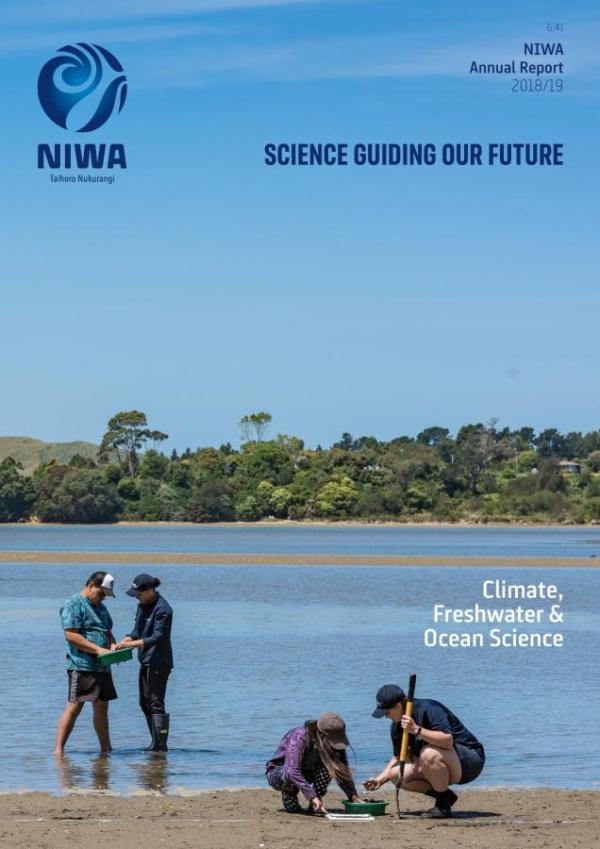When the first sparks flickered into life at Pigeon Valley near Nelson on 5 February, it hadn’t rained for more than 40 days. The rapidly drying conditions in the Tasman region meant NIWA’s forecasting team were already keeping a close eye on the area, so when Fire and Emergency New Zealand rang needing help fast, the team was ready.
Download the NIWA Annual Report 2018/19
Over the ensuing weeks as firefighters battled to control the blazes, NIWA forecasters were alongside the incident management team providing highly detailed forecasts, predicting wind changes hillside by hillside – and getting it right.
The devastating Nelson fires are just one example of how NIWA continues to provide high quality science, leadership and expertise where it matters most.
In the past 12 months the need for excellent environmental science has risen in public prominence, nationally and globally, to a level that is now unprecedented. Around the world this has largely been driven by ongoing extreme weather events and concern for the future of our oceans, but, at home, improving the quality of our rivers and streams has also gained momentum.
Under the spotlight of this public focus, NIWA has again had a successful and productive year. As the pre-eminent provider of climate, freshwater and ocean science, we have advised, responded, discovered and communicated vital information to equip New Zealanders for future environmental challenges.
This ability comes with the expectation that we foster strong international collaborations, work closely with other institutions within New Zealand and build on our diverse and inclusive workplace.
In our 2018/19 Statement of Corporate Intent, we acknowledged that the biggest challenge for NIWA lies in the rapid advance in digital technologies that are increasingly altering the way science is done and what is possible. We have addressed the need to accelerate building our digital capabilities and integrating that effectively with our science. This strategy will help provide an operating environment of expanding opportunities.
This year, as part of our response to a growing public focus on the impacts of climate change in New Zealand, we invited our stakeholders to Te Papa in Wellington for a national climate conversation we called Climate Matters.
The focus of this day-long event was to enable community, sector and government decision makers to engage with NIWA about the research, tools and information they needed to respond to the climate challenge. The results showed an overwhelming affirmation of NIWA’s climate change research as well as revealing new opportunities as New Zealand looks to mitigate and adapt to a changing climate in the coming years. The development of NIWA’s science strategy will see a greater emphasis on accommodating learnings from this successful engagement.
Just ahead of Climate Matters, NIWA hosted a conference to celebrate the first five years of the Unified Model Partnership – a collaborative effort that resulted in one of the world’s most successful forecasting and climate prediction systems that draws on a wide range of science and high-performance computing capacity.
This partnership, in which NIWA is a foundation member and key player, demonstrates the power of international collaboration and has proved invaluable in forecasting tropical cyclones, floods, sea-level storm surges and fire risks across the world.
NIWA hosted many other national and international meetings of scientists over the year, building on important partnerships and setting the agenda for future projects.
In early January NIWA’s flagship research vessel Tangaroa left Wellington for a six-week voyage to Antarctica, sailing as far south as 76ᵒ 30’S – just 30km short of its southernmost voyage.
Working among ice floes, strong winds and heavy swells, the 21 New Zealand and international scientists and 19-strong crew faced an imposing research schedule setting up long-term monitoring programmes for the Ross Sea Marine Protected Area (MPA).
Data collected on the voyage included whale, fish and plankton abundance; seabed samples; and oceanographic and atmospheric conditions. It will help establish the crucial baselines needed to assess the MPA’s future impact.
Meanwhile, our workload continues to be high, necessitating the addition of 27 new positions during the year, taking our total staff to 697. During the year we maintained our focus on increasing staff understanding and awareness of the value and importance of diversity in the workplace, and we remain committed to continuing to promote inclusive work practices.
Revenue at $161.3 million for the year was equal to budget and materially better than the previous year. Earnings before interest, tax, depreciation and amortisation (EBITDA) was $27.4 million, and net profit after tax was $6.2 million – a pleasing financial result
Please refer to the NIWA Annual Report 2018/19 for the complete Chairman & Chief Executive’s review of NIWA’s 2018/19 year.

